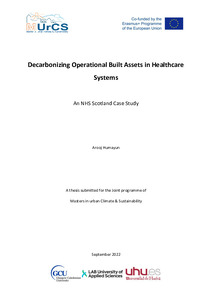Decarbonizing operational built assets in healthcare systems
Humayun, Arooj (2022)
Julkaisun pysyvä osoite on
https://urn.fi/URN:NBN:fi:amk-2022111422643
https://urn.fi/URN:NBN:fi:amk-2022111422643
Tiivistelmä
Decarbonization in healthcare reduces the impact of climate change on the environment and, as a result, the demand for healthcare services. Hospitals are the hub of all healthcare activity and also play a vital role in the urban community, making them an ideal initial mark for decarbonization research. This study investigates how hospitals in Glasgow can reduce their operational emissions using Gartnavel Hospital as a case study. The site and its available emission metrics were scrutinized in to identify five major streams that contribute the most to operational emissions. These were energy, waste, water, anaesthetic gases, and transport. To determine why these streams were contributing significantly to these streams, on-site surveys and interviews with relevant resources were conducted. The findings revealed dilapidated infrastructure, lack of energy-efficient technology, wasteful practices, insufficient amount of staff training and expertise in sustainability, resource division, lack of monitoring and targeting, and unclear governance hierarchy to be the cause for the high emissions count on site. A SWOT analysis was then conducted for the site to identify main variables. A qualitative literature review was conducted using NVivo software to identify best practices and themes for emissions reduction in the commercial built and healthcare setting. The findings from this review were correlated with the problems identified onsite for Gartnavel Hospital and translated to recommendations for site improvement. It was found that Gartnavel Hospital needs to reduce energy consumption through infrastructure upgradation, invest in onsite renewable generation, practice freight consolidation, and enhance waste segregation for immediate emissions reductions. Interventions for each stream were highlighted in the form of an Action Research Framework that would aid future decision making for the local healthcare board. The framework divides recommendations into 4 phases: Planning, Acting, Observing and Reflecting. Primarily, an emissions inventory needs to be built for the hospital before any new interventions can be implemented as this will allow measurement of effectiveness. This research also shows the impression of healthcare institutions in Glasgow using GIS to map out healthcare institutes in the city. Decarbonization at Gartnavel Hospital can be revolutionary and pave the path for a change at other healthcare institutes in the city as well.
